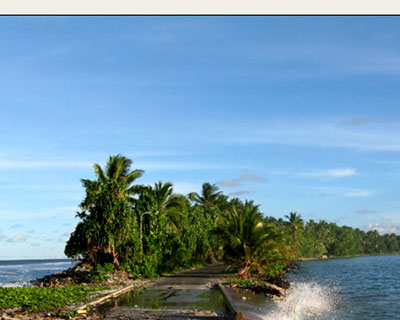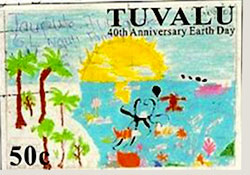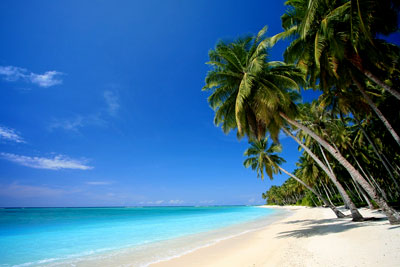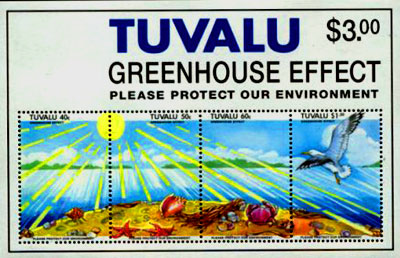|
Travelogues Tuvalu Islands in the South Pacific
|
|||||
|
Travel Tales Abroad • Thailand • Gulmohurs to Pohutukawas • Istanbul Diary • Bamfield Sounds • Puri & the Pacific • The Bear Trail • A Seattle I Know • Arabian Nights & Dates • European Diary • South by Virginia • Indonesia • Land of Rising Sun • Peaceful Dragon • Norwegian New Year • Observing Sri Lanka | ||||
 A coir expert accompanied me from London. We flew to Los Angeles,
and then on to Nandy and Suva in Fiji, via Honolulu. We landed fairly disoriented. Our taxi-driver was a great-great-grandson of an indentured migrant from Bihar. As he said, he spoke in 'tutta-futta-Hindi. He took us to an hotel in Suva, chatting effusively all the way, unmindful that we were half asleep.
A coir expert accompanied me from London. We flew to Los Angeles,
and then on to Nandy and Suva in Fiji, via Honolulu. We landed fairly disoriented. Our taxi-driver was a great-great-grandson of an indentured migrant from Bihar. As he said, he spoke in 'tutta-futta-Hindi. He took us to an hotel in Suva, chatting effusively all the way, unmindful that we were half asleep.
After a day's exploration, we found ourselves in a fragile five-seater-plane, flying over the Pacific for some three hours. The plane landed on a football field in Funafuti, capital of Tuvalu. The players vacate the field when the plane is sighted and then resume the game, as soon as the field is clear. Near the airfield was the Parliament House of Tuvalu, a broad thatched shed . This doubles as the Public Club house in the evenings. When the parliament-session was on, the locals discreetly walked away.
The paying-guest-house that we stayed in served hot meals. The menu that normally featured sizzling pork, was graciously altered to rice and vegetables to accommodate my culinary habits. Apart from us, there were two other guests. A Japanese retiree from the World Bank and a wealthy trader hopping all over the South- Pacific, who was of the Bahai faith. We attended a Bahai weekly prayer-meeting at Funafuti and I was reminded of the Lotus -temple in Delhi.
Local homes had kitchens separated from the main house. Here, buxom women could be spotted hand- crushing coconut-kernels, using the coconut-milk for cooking and throwing the rich residue to the many pigs who would eventually turn into sizzling pork! The only source of drinking water was harvested rain water collected from the roof and stored underground. The island actually had a prison: a fenced hut, remotely located , where a lone prisoner was serving his term spinning coir by 'twisting and more twisting of coconut-fiber' as they put it. We also visited Vaitupu island which is a half- hour flight from Funafuti by an amphibian-plane , piloted by a couple of young New Zealanders, who doubled as porters. Vaitupu had a Research Station for coconuts headed by an 'American Expert'. There were some experimental drying units for making copra from coconut- kernels. Local transportation was the only tractor the island had. The only other vehicle on the island was an army-tank, rusting since the Second World War.
Planning a technically feasible and economically viable micro-project in a remote island has its own challenges and thrills. Images of the island stay with me till this day, and the garland of cowries the community gifted us in farewell remains as a treasured reminder of the visit.
|
|||||
Editor: Romola Butalia (c) India Travelogue. All rights reserved. |
|||||
 Way back in the early eighties, I had a two-week-exposure to the
remote islands of Tuvalu, North of Fiji, in the South Pacific. The assignment was to help set up a viable project based on the fact that coconuts were so plentiful they lay scattered without anyone picking them up.
Way back in the early eighties, I had a two-week-exposure to the
remote islands of Tuvalu, North of Fiji, in the South Pacific. The assignment was to help set up a viable project based on the fact that coconuts were so plentiful they lay scattered without anyone picking them up.
 Funafuti had a population of some eight thousand, with a Governor, appointed
by Her Majesty the Queen of England. The Governor had a Rolls Royce, the only car
in the eight mile long island. There was a branch of Grindlays Bank
with a queue of young women, encashing cheques before their long weekend.
They were the employees of Tuvalu-International Philately Bureau, the sole
foreign-exchange-earner and the largest contributor to their national GDP,
which trades internationally its exotic stamps, designed and printed in
England. There was also a supermarket that imported all its goods on sale.
Funafuti had a population of some eight thousand, with a Governor, appointed
by Her Majesty the Queen of England. The Governor had a Rolls Royce, the only car
in the eight mile long island. There was a branch of Grindlays Bank
with a queue of young women, encashing cheques before their long weekend.
They were the employees of Tuvalu-International Philately Bureau, the sole
foreign-exchange-earner and the largest contributor to their national GDP,
which trades internationally its exotic stamps, designed and printed in
England. There was also a supermarket that imported all its goods on sale.
 A correspondent from the community-radio interviewed us and broadcast the interaction the next morning. After this local residents would greet us warmly
during our morning walks. I remember the fruit laden trees on the
walks. The radio station also doubled as a centre for 'wireless education',
preparing local children for Senior Cambridge examinations. Our evening
walks were usually to the shallow bay on the other side of the island
where one could wade through the water and view shoals of large fish, or perhaps
dolphins, frolicking in the far distance. The sea and sky in their electric shades of blue: azure, cobalt, indigo, sapphire, blended into each other without ever quite merging.
A correspondent from the community-radio interviewed us and broadcast the interaction the next morning. After this local residents would greet us warmly
during our morning walks. I remember the fruit laden trees on the
walks. The radio station also doubled as a centre for 'wireless education',
preparing local children for Senior Cambridge examinations. Our evening
walks were usually to the shallow bay on the other side of the island
where one could wade through the water and view shoals of large fish, or perhaps
dolphins, frolicking in the far distance. The sea and sky in their electric shades of blue: azure, cobalt, indigo, sapphire, blended into each other without ever quite merging.
 Because the only ferry-ship of Tuvalu had run aground two days earlier,
many passengers were stranded and were now dependent on the amphibian plane
resulting in many extra flights and unscheduled flights. While we admired
the stamina and dedication of the New Zealand-pilots, we were also concerned that we may find ourselves stranded here after sunset. Much to
our relief we were finally offered seats on a flight which consisted of a
bevy of resident school girls on vacation from Funafuti.The pilots sized us
all up and balanced the plane by instructing, "big ones sit in front, the
smaller ones behind", which reminded me of similar instructions that used to
be given by a bullock cart wallah at home in India, many years ago. The half- hour flight
took us back to the Funafuti football field where our landing again interrupted
a game in progress.
Because the only ferry-ship of Tuvalu had run aground two days earlier,
many passengers were stranded and were now dependent on the amphibian plane
resulting in many extra flights and unscheduled flights. While we admired
the stamina and dedication of the New Zealand-pilots, we were also concerned that we may find ourselves stranded here after sunset. Much to
our relief we were finally offered seats on a flight which consisted of a
bevy of resident school girls on vacation from Funafuti.The pilots sized us
all up and balanced the plane by instructing, "big ones sit in front, the
smaller ones behind", which reminded me of similar instructions that used to
be given by a bullock cart wallah at home in India, many years ago. The half- hour flight
took us back to the Funafuti football field where our landing again interrupted
a game in progress.